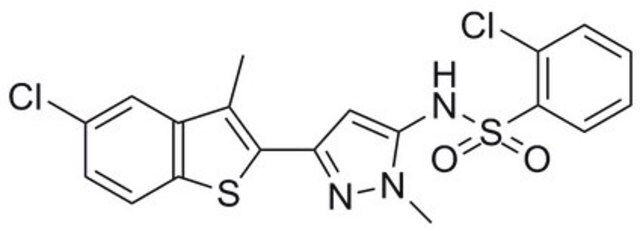557403
RNA Polymerase III Inhibitor
RNA Polymerase III Inhibitor, CAS 577784-91-9, is a cell-permeable inhibitor of RNA Polymerase III (IC₅₀ = 27 and 32 µM for human and S. cerevisiae RNA Pol III, respectively).
Synonym(s):
RNA Polymerase III Inhibitor, ML-60218, N-[1-(3-(5-Chloro-3-methylbenzo[b]thiophen-2-yl-1-methyl-1H-pyrazol-5-yl)]-2-chlorobenzenesulfonamide
About This Item
Recommended Products
Quality Level
Assay
≥95% (HPLC)
form
solid
manufacturer/tradename
Calbiochem®
storage condition
OK to freeze
protect from light
color
off-white
solubility
DMSO: 15 mg/mL
shipped in
ambient
storage temp.
2-8°C
InChI
1S/C19H15Cl2N3O2S2/c1-11-13-9-12(20)7-8-16(13)27-19(11)15-10-18(24(2)22-15)23-28(25,26)17-6-4-3-5-14(17)21/h3-10,23H,1-2H3
InChI key
BVBDTTLISMIOJY-UHFFFAOYSA-N
General description
Biochem/physiol Actions
activity against RNA Polymerase III
Packaging
Warning
Preparation Note
Reconstitution
Other Notes
Legal Information
Storage Class Code
11 - Combustible Solids
WGK
WGK 1
Flash Point(F)
Not applicable
Flash Point(C)
Not applicable
Certificates of Analysis (COA)
Search for Certificates of Analysis (COA) by entering the products Lot/Batch Number. Lot and Batch Numbers can be found on a product’s label following the words ‘Lot’ or ‘Batch’.
Already Own This Product?
Find documentation for the products that you have recently purchased in the Document Library.
Our team of scientists has experience in all areas of research including Life Science, Material Science, Chemical Synthesis, Chromatography, Analytical and many others.
Contact Technical Service







![Digoxigenin-11-dUTP, alkali-labile =85% (HPLC), solution, pkg of 25 μL (11573152910 [1 mM]), pkg of 125 μL (11573179910 [1 mM]]])](/deepweb/assets/sigmaaldrich/product/images/352/091/ef743cea-ccd8-44f1-8f3b-dec5a1e4f5d1/640/ef743cea-ccd8-44f1-8f3b-dec5a1e4f5d1.jpg)
